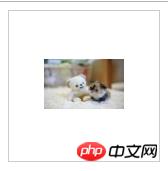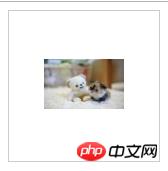How to vertically center images in divs using css
This article mainly introduces how to vertically center images in divs using css. It has certain reference value and I hope it can help everyone.
We usually work on pages We often encounter situations where we are asked to display an image in the middle of a div but often don’t know how to do it. Today we will share several commonly used css codes to achieve vertical centering of images in divs
HTML code
<div> <img src="images/1.jpg"> </div>
Method 1
Use position and margin to realize
Allow child elements by setting the absolute positioning attribute to the parent element Relative to div positioning
relative means retaining the original position for positioning and positioning relative to its own original position
absolute means positioning away from the original position and relative to the nearest positioned parent If there is no positioned parent element, it will be positioned relative to the document
Note: To make the top, bottom, left and right of the child element 0, then set margin:auto It will automatically center vertically
The code is as follows
div{
width:200px;
height:200px;
border: 1px solid #ccc;
position: relative;//父元素设置绝对定位
}
img{
position: absolute;//相对定位
width:80px;
height:50px;
top:0;
left:0;
right:0;
bottom:0;
margin:auto;//使其垂直居中
}Rendering

Method 2
Use the three attributes of display: table-cell; vertical-align: middle; text-align: center; to achieve
display:table-cell: will be used as a table cell Display (similar to
vertical-align: middle;Set vertical alignment, applicable to row-level elements
text-align: center: Sets the horizontal alignment. This property sets the horizontal alignment of text within block-level elements by specifying the point at which the line box is aligned.
div{
width:200px;
height: 200px;
margin:300px auto;
display: table-cell;//作为一个表格单元格显示
vertical-align: middle;//设置垂直对齐方式
text-align: center;//设置水平对其方式
border:1px solid #ccc;
}
img {
width:80px;
height:50px;
}Rendering

Method 3
Use position, and margin- Implementation of top and margin-left
In this method, attention should be paid to the setting of margin-top and margin-left values. They should be set to half the height and width of the element, and both should be negative values
For example, margin-top: -40px means that the element is 40px upward from the upper boundary, and margin-top: 40px means that it is 40px downward from the upper boundary element
div{
width:200px;
height:200px;
border: 1px solid #ccc;
position: relative;
}
img{
position: absolute;
width:80px;
height: 50px;
top:50%;
left:50%;
margin-top: -40px;//向上40px
margin-left: -25px;//向左25px
}Rendering

Summary: There are many ways to use css to vertically center images in divs. The above are the three methods I have summarized. You are welcome to add the rest. I hope This article can help everyone learn page layout.
The above is the detailed content of How to vertically center images in divs using css. For more information, please follow other related articles on the PHP Chinese website!

Hot AI Tools

Undresser.AI Undress
AI-powered app for creating realistic nude photos

AI Clothes Remover
Online AI tool for removing clothes from photos.

Undress AI Tool
Undress images for free

Clothoff.io
AI clothes remover

Video Face Swap
Swap faces in any video effortlessly with our completely free AI face swap tool!

Hot Article

Hot Tools

Notepad++7.3.1
Easy-to-use and free code editor

SublimeText3 Chinese version
Chinese version, very easy to use

Zend Studio 13.0.1
Powerful PHP integrated development environment

Dreamweaver CS6
Visual web development tools

SublimeText3 Mac version
God-level code editing software (SublimeText3)

Hot Topics
 1386
1386
 52
52
 Flexible application skills of position attribute in H5
Dec 27, 2023 pm 01:05 PM
Flexible application skills of position attribute in H5
Dec 27, 2023 pm 01:05 PM
How to flexibly use the position attribute in H5. In H5 development, the positioning and layout of elements are often involved. At this time, the CSS position property will come into play. The position attribute can control the positioning of elements on the page, including relative positioning, absolute positioning, fixed positioning and sticky positioning. This article will introduce in detail how to flexibly use the position attribute in H5 development.
 CSS layout property optimization tips: position sticky and flexbox
Oct 20, 2023 pm 03:15 PM
CSS layout property optimization tips: position sticky and flexbox
Oct 20, 2023 pm 03:15 PM
CSS layout attribute optimization tips: positionsticky and flexbox In web development, layout is a very important aspect. A good layout structure can improve the user experience and make the page more beautiful and easy to navigate. CSS layout properties are the key to achieving this goal. In this article, I will introduce two commonly used CSS layout property optimization techniques: positionsticky and flexbox, and provide specific code examples. 1. positions
 How to put div at the bottom in html
Mar 02, 2021 pm 05:44 PM
How to put div at the bottom in html
Mar 02, 2021 pm 05:44 PM
How to place a div at the bottom of HTML: 1. Use the position attribute to position the div tag relative to the browser window, with the syntax "div{position:fixed;}"; 2. Set the distance to the bottom to 0 to permanently place the div at At the bottom of the page, the syntax is "div{bottom:0;}".
 How to use position in h5
Dec 26, 2023 pm 01:39 PM
How to use position in h5
Dec 26, 2023 pm 01:39 PM
In H5, you can use the position attribute to control the positioning of elements through CSS: 1. Relative positioning, the syntax is "style="position: relative;"; 2. Absolute positioning, the syntax is "style="position: absolute;" "; 3. Fixed positioning, the syntax is "style="position: fixed;" and so on.
 Detailed explanation of CSS border properties: padding, margin and border
Oct 21, 2023 am 11:07 AM
Detailed explanation of CSS border properties: padding, margin and border
Oct 21, 2023 am 11:07 AM
CSS border properties explained in detail: padding, margin and borderCSS is a style sheet language used to control and layout web page elements. In web design, the border attribute is one of the most important parts. This article will introduce in detail how to use the border attribute in CSS and provide specific code examples. padding The padding property is used to set the padding of an element, which is the space between the element's content and the element's borders. We can set padding using positive numbers or percentage values
 What attributes does position have?
Oct 10, 2023 am 11:18 AM
What attributes does position have?
Oct 10, 2023 am 11:18 AM
The position attribute values include static, relative, absolute, fixed, sticky, etc. Detailed introduction: 1. static is the default value of the position attribute, which means that the elements are laid out according to the normal document flow without special positioning. The position of the elements is determined by their order in the HTML document and cannot be passed through top, right, and bottom. Adjust with the left attribute; 2. relative is relative positioning and so on.
 What does margin mean in css
Dec 18, 2023 am 10:30 AM
What does margin mean in css
Dec 18, 2023 am 10:30 AM
In CSS, margin is a property used to set the outer margins of an element. Margins are the space between an element's border and its content. Margin can accept the following values: 1. A single value: for example, margin: 10px; Set all four margins (top, right, bottom, left) to 10 pixels; 2. Two values: for example, margin : 10px 20px; Set the top and bottom margins to 10 pixels, and the left and right margins to 20 pixels; 3, four values, and so on.
 How to clear position in css
Oct 07, 2023 pm 12:02 PM
How to clear position in css
Oct 07, 2023 pm 12:02 PM
How to clear position in css: 1. Use the static attribute, which can be set to static to clear the position attribute; 2. Use the inherit attribute to clear the position attribute of the element and inherit the position attribute of the parent element; 3. Use the unset attribute, Restore the attributes to their default values and clear the position attribute of the element; 4. Use the !important rule, which will override other style rules and clear the position attribute, etc.




